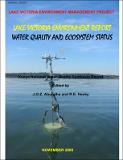| dc.description.abstract | The Winam Gulf’s aquatic environment (Figure 1) represents a considerable part of
the economic potential of the country, e.g. with regard to fisheries and navigation. However,
the use, the management and the preservation of the aquatic ecosystem and its natural
resources require an adequate knowledge of physical, chemical and biological processes and
features within this environment.
Although there are many features of Lake Victoria, which are of intense interest to
scientist, it is fish biology and economics that have received the most attention The study program had a multidisciplinary character and included the themes
specified in the objectives. Methods of research within the seven interrelated themes are given
in this report. Together with data from historical sources and literature collect during the
LVEMP project, they provide basic knowledge about the meteorology, river regime,
hydraulics, sediment transport and deposition, land use characteristics of their drainage basins
(watershed), nutrient fluxes, biota associations and environmental impacts The Water Quality and Ecosystem Management Components of the Lake Victoria
Environmental Management Project (LVEMP) in the three East African countries
collaborating on LVEMP phase 1 have made considerable progress towards understanding
Lake Victoria water quality and its ecosystem as well as effects of resource utilization and
exploitation on the lake and its catchment. The components have been able to collect
considerable amounts of data and information. In order to achieve LVEMP objectives and
Water Quality and Ecosystem Management objectives, in particular, a well-coordinated
analysis, synthesis and interpretation of all relevant data was required. This synthetic report
documents and explains the changes that have taken place over the recent decades, and it
provide an overview of the present water quality status of the lake as well as identifying past
changes and continuing trends that may require remedial action. The report provides enough
detailed information and spatial resolution at the regional scale to support environmental
decision making in regards to possible remediation of undesirable changes that have reduced
beneficial uses of Lake Victoria biological and water resources. To achieve the desired
synthesis report, a National Consultant, Dr Joseph Abuodha and an international consultant,
Prof. Robert Hecky of the University of Waterloo, Canada, were retained to guide and assist
the process of preparation of this National Report as well as integration of these national
reports and other studies into the required regional synthesis report. The consultants directly
proceeded to visit the National Executive Secretariat and to engage the WQEM component in
a working session during the Easter Weekend on 27th and 28th March 2005 as called for in the
consultancy contract. An Inception Report was subsequently submitted, giving the results of
that working session as well as the overall strategy and timetable for accomplishing the
required national synthesis report by end of July 2005 and the regional synthesis report by the
end of October 2005. | en_US |

